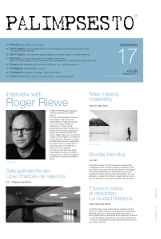PROYECTAR DESDE EL FACTOR HUMANO. EL DIÁLOGO CON EL HOMBRE DE JAVIER CARVAJAL.
DOI:
https://doi.org/10.5821/palimpsesto.17.5371Palabras clave:
casa Carvajal, casa Valdecasas, significación, humanismo, habitarResumen
El artículo indaga sobre la figura de Javier Carvajal y su consideración de la voluntad activa del “otro” en los inicios del proceso creativo, ante su convicción de que la crisis de su tiempo es la crisis de un modelo abstracto de hombre que solicita del arquitecto un renacido humanismo.
Las casas de Somosaguas se exponen como paradigma de su concepto antropológico. En ellas la respuesta requiere estructurar la pluralidad de dos formas de habitar en un conjunto con vocación de unidad. Sólo desde una actitud de diálogo es posible reconciliar soluciones opuestas.
La casa es el espacio más próximo al hombre .El significado de una acción tan esencial como contener se impregna de dos polos constitutivos de la condición humana: la necesidad de introspección y en el extremo el existir en una época, con los otros, en el mundo.
Para Carvajal la huella de la existencia deja su herida en el territorio configurando la historia, apoyo para la creación un futuro perpetuamente renovado.
Publicado
Número
Sección
Licencia
CRITERIOS DE PROTECCIÓN Y PROPIEDAD INTELECTUAL
Los autores que publican en Palimpsesto están de acuerdo con los siguientes términos:
1. Los autores conservan los derechos de autor y garantizan a la revista el derecho de una Creative Commons Reconocimiento-NoComercial-SinObraDerivada (CC BY-NC-ND) que permite a otros compartir el trabajo con un reconocimiento de la autoría.
2. Los autores pueden establecer por separado acuerdos adicionales para la distribución no exclusiva de la versión de la obra publicada en la revista (por ejemplo, situarlo en un repositorio institucional o publicarlo en un libro).
3. Se permite y se anima a los autores a difundir sus trabajos electrónicamente (por ejemplo, en repositorios institucionales o en su propio sitio web) antes y durante el proceso de envío, ya que puede dar lugar a intercambios productivos, así como a una citación más temprana y mayor de los trabajos publicados (Véase The Effect of Open Access) (en inglés)
4. El autor o cedente del material que se entrega para publicación autoriza a la revista Palimpsesto para que publique, sin obligación alguna (económica o de otra naturaleza), el contenido del referido material tanto en formato papel, como en digital, así como en cualquier otro medio.
5. El autor o cedente garantiza ser el titular de los derechos de Propiedad Intelectural sobre los contenidos proporcionados, es decir, sobre el propio texto e imágenes/fotografías/obras fotográficas que se incorporan en su artículo.
6. El autor o cendente, exime a la revista Palimpsesto de toda y cualquier responsabilidad con relación a la violación de derechos de autor, comprometiéndose a emplear todos sus esfuerzos para auxiliar a la revista Palimpsesto en la defensa de cualquier acusación, medidas extrajudiciales y/o judiciales. Asimismo, asume el abono a la revista Palimpsesto de cualquier cantidad o indemnización que ésta tenga que abonar a terceros por el incumplimiento de estas obligaciones, ya sea por decisiones judicial, arbitral y/o administrativa.
7. El envío y su posterior aceptación de un texto por parte de los autores implica automáticamente la declaración de no plagio de su contenido







